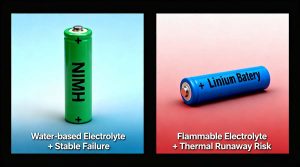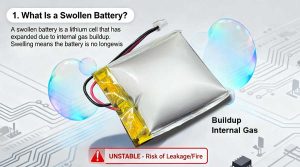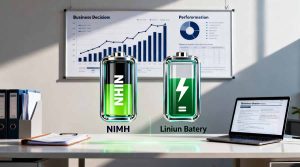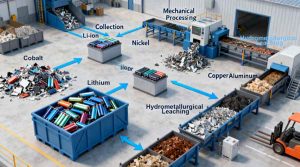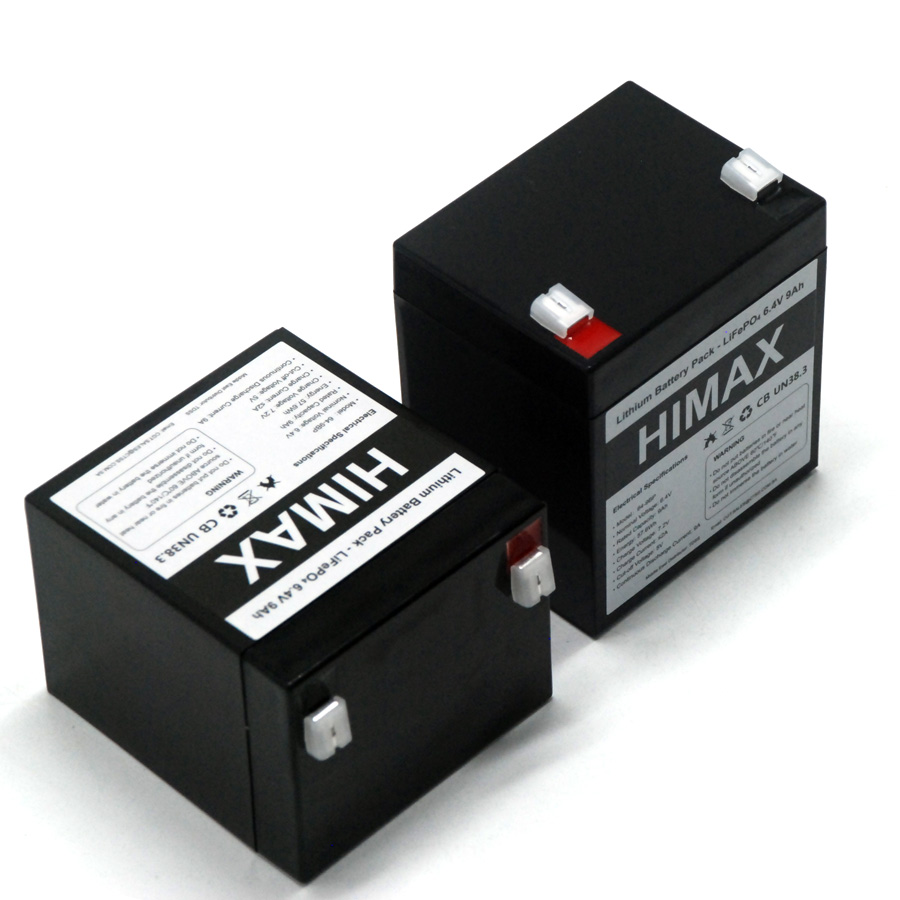When people talk about rechargeable batteries today, the conversation usually centers around lithium. Lithium-ion technology powers our phones, laptops, electric vehicles, and countless smart devices. But when safety concerns come up—thermal runaway, swelling, or fire risk—many users start to wonder: Are nickel-metal hydride batteries actually safer than lithium?
What Makes a NiMH Battery Different?
A NiMH battery uses nickel oxyhydroxide as the positive electrode and a hydrogen-absorbing alloy as the negative electrode. The chemistry is water-based, stable, and has been used for decades. Most people know NiMH cells from AA and AAA rechargeable batteries, hybrid cars, medical tools, and industrial equipment.
Lithium batteries are very different. They use organic electrolytes that are flammable, and their voltage is much higher. Lithium-ion technology is newer, more energy-dense, and more sensitive to temperature and charging conditions.
These structural and chemical differences heavily influence battery safety, failure risks, and user experience.
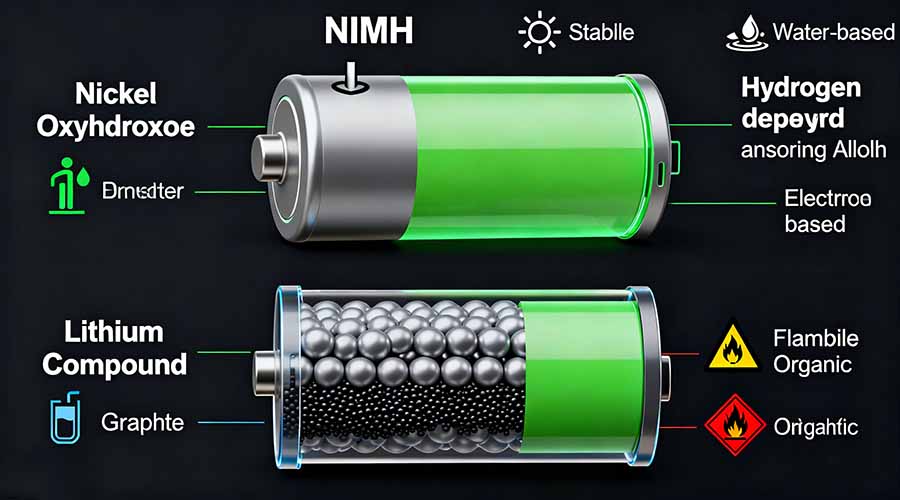
Why Many Users Believe NiMH Is “Safer”
The reputation of the nickel-metal hydride battery comes from one core fact: it is much more resistant to fire. The electrolyte is water-based and does not ignite when damaged. Even under stress, NiMH chemistry releases far less energy than lithium, and it rarely reaches temperatures high enough to start a fire.
Several easy-to-understand reasons support this belief:
- NiMH does not use flammable solvents.
- NiMH generates less heat during normal operation.
- NiMH is more tolerant of overcharging.
- NiMH has fewer catastrophic failure modes.
- NiMH is mechanically robust and less sensitive to punctures.
When people say that a NiMH battery is “safer,” they usually mean that it is less likely to catch fire or explode.
Understanding Battery Safety: What Does “Safer” Actually Mean?
Safety is not a single measurement. Instead, it includes multiple factors:
- Thermal stability
- Chemical behavior
- Failure behavior
- Electrical tolerance
- Risk of user harm
- Environmental behavior
A battery can be “safer” in one category but not in another. To get the full picture, we must look at the risk profile of each technology.
How NiMH Cells Behave Under Stress
A NiMH cell tends to fail in predictable and less harmful ways. When a NiMH pack overheats, the pressure inside the cell gradually builds. Most NiMH packs include a pressure relief valve. If the pressure becomes too high, the valve opens and vents harmless gases.
This means:
- No flames
- No explosion
- Minimal risk of spreading fire
NiMH batteries may leak electrolyte, but the leakage is usually mild and non-flammable. The primary safety concern is corrosion, not combustion.
This relatively calm failure behavior is the foundation of the battery safety reputation of NiMH technology.
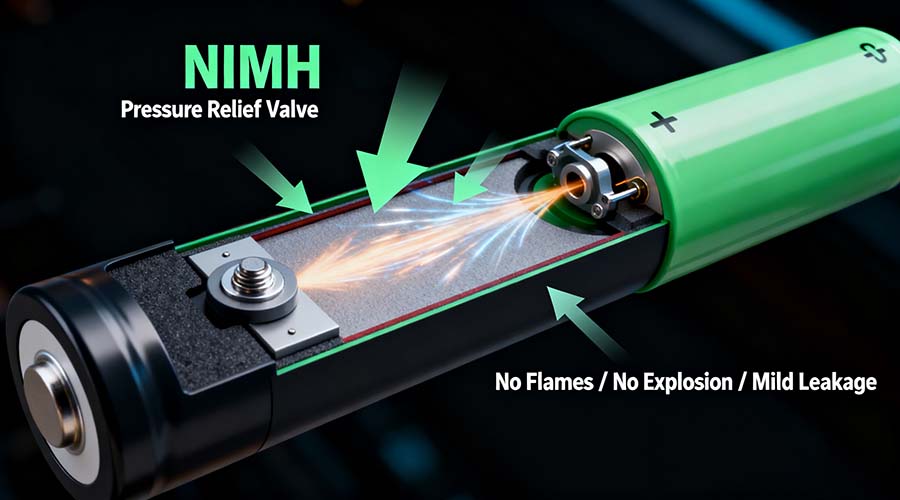
How Lithium Batteries Fail When Things Go Wrong
Lithium-ion chemistry is different. Under stress, lithium cells can enter thermal runaway. This rapid overheating can trigger:
- Flames
- Smoke
- Explosions
- Propagation to nearby cells
Lithium cells contain flammable electrolytes and can release oxygen during decomposition, which feeds combustion. Even a tiny manufacturing flaw, internal short, or damaged separator can start a chain reaction.
Lithium batteries today include advanced overcharge protection, current-limit chips, temperature sensors, and smart battery management systems. These safety features dramatically reduce risk—but the chemistry still carries inherent fire potential.

Is NiMH Actually “Safer” in Day-to-Day Use?
In everyday use, the answer is generally yes.
A nickel-metal hydride battery is less likely to catch fire, less sensitive to heat, and more tolerant of electrical mistakes.
NiMH batteries can handle:
- Occasional deep discharges
- Mild overcharging
- High-current bursts
- Mechanical stress
They are also safer for inexperienced users, children’s toys, and environments where thermal events are unacceptable—such as medical clinics or warehouses.
When Lithium Batteries Might Be the Safer Choice
Although NiMH chemistry is more stable, lithium technology can sometimes be safer thanks to intelligent design. Modern lithium packs include:
- Battery management systems (BMS)
- Thermal sensors
- Short-circuit protection
- Cell-balancing circuits
- Automatic cutoff mechanisms
If a lithium pack is well-designed and certified, it can be extremely safe in normal operation.
Lithium may be a better choice when:
- The device requires high energy density
- Weight must be minimized
- The manufacturer provides strong safety electronics
- Operating temperature is well controlled
A poorly designed lithium pack is risky. A high-quality pack with a strong BMS can be very reliable. Safety depends not only on chemistry but also on engineering.
The tradeoff is simple:
- Lower energy density
- Slower self-discharge (with modern low-self-discharge designs)
- Increased durability under stress
- Higher intrinsic safety
- Much higher energy density
- Faster charging
- Much lighter
- Higher risk if abused
Users must choose between these characteristics based on the needs of their project or product.
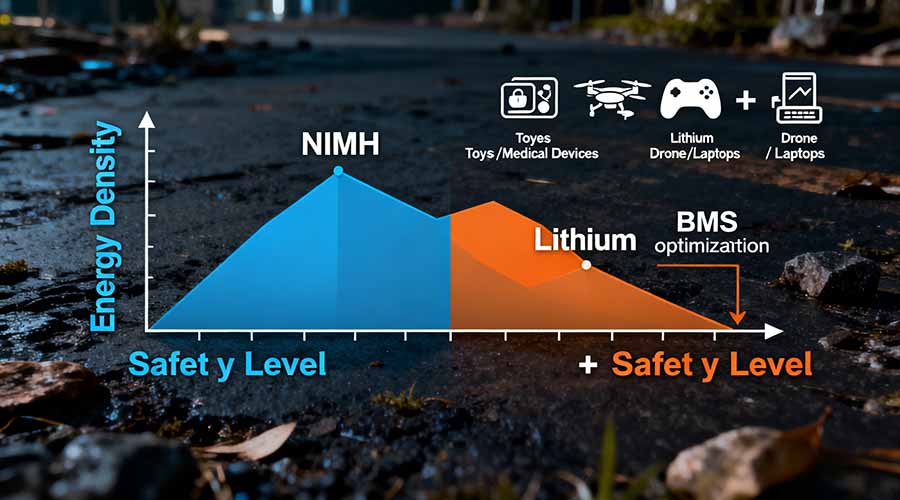
How Users Should Think About Battery Safety in Real Life
If you are using a household device—remotes, flashlights, medical meters, toys—a NiMH battery is a safe and reliable choice.
If you need high power for drones, e-mobility, or laptops, lithium batteries make more sense—but must be handled with appropriate care.
A few simple rules improve safety for both chemistries:
- Use certified chargers
- Avoid storing batteries in extreme temperatures
- Inspect cells for damage
- Never mix old and new batteries
- Keep batteries away from sharp metal tools
Chemistry matters, but so does behavior.
Environmental Safety: Another Advantage of NiMH
Many users forget that battery safety also includes environmental impact. NiMH batteries contain no lithium metal, no heavy metals such as lead or cadmium, and no flammable organic solvents.
Lithium batteries require special disposal processes and can ignite when crushed or exposed to water during recycling.
NiMH cells are more benign and easier to recycle safely.
Why Some Industries Still Prefer NiMH Today
Industries that require uncompromising stability still use NiMH cells, including:
- Medical equipment manufacturers
- Security system integrators
- Warehouse scanners and industrial handhelds
- Emergency lighting systems
- Aerospace auxiliary systems
For these applications, reliability and stable failure behavior are more important than energy density
Introducing HiMAX NiMH Battery
Lithium batteries power the modern world, but they come with real risks. A nickel-metal hydride battery offers unmatched stability and predictable performance. It is not always the most powerful option, but it is often the safest one. So if your project values safety above all else, NiMH remains one of the most trusted chemistries in use today.
If you are looking for a high-quality, reliable NiMH battery, HiMAX offers industry-leading solutions built for stability, long cycle life, and dependable performance. HiMAX NiMH batteries feature advanced materials, low self-discharge options, customizable pack configurations, and strict safety testing. Whether you need power for consumer products, industrial devices, or specialized equipment, HiMAX NiMH batteries deliver the safety, consistency, and reliability your applications demand.
Find articles related to NiMH Battery

